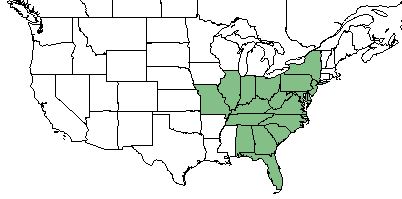Rudbeckia fulgida
| Rudbeckia fulgida | |
|---|---|

| |
| Photo by Chris Evans, University of Illinois, Bugwood.org hosted at Forestryimages.org | |
| Scientific classification | |
| Kingdom: | Plantae |
| Division: | Magnoliophyta - Flowering plants |
| Class: | Magnoliopsida - Dicots |
| Order: | Asterales |
| Family: | Asteraceae |
| Genus: | Rudbeckia |
| Species: | R. fulgida |
| Binomial name | |
| Rudbeckia fulgida Aiton | |

| |
| Natural range of Rudbeckia fulgida from USDA NRCS Plants Database. | |
Contents
Taxonomic Notes
Synonym: R. acuminata(C.L. Boynton & Beadle), R. foliosa (C.L. Boynton & Beadle), R. truncata (Small)
Variety: Rudbeckia fulgida var. spathulata (Michaux)Perdue, Rudbeckia fulgida var. speciosa (Wendroth) Perdue, Rudbeckia fulgida var. sullivantii (C.L. Boynton & Beadle), Rudbeckia fulgida var. umbrosa (C.L. Boynton & Beadle)
Description
R. fulgida is a perennial forb/herb of the Asteraceae family that is native to North America. [1]
Distribution
R. fulgida is found specifically in Florida, Georgia, South Carolina, North Carolina, Virginia, Maryland, Delaware, New Jersey, Pennsylvania, New York, Ohio, West Virginia, Kentucky, Indiana, Tennessee, Illinois, Missouri, and Alabama.[1]
Ecology
Habitat
R. fulgida is found in habitats of dry to wet meadows with some varieties found in bottomlands, bogs, moist forests and woodlands, and calcareous slopes. [2]
R. fulgida have been found in environments with loamy sand or chaulky clay.[3]
Phenology
Flowering occurs i January, and February, predominately in April and May, and some occurring in July and September. [4]
Conservation and Management
R. fulgida is considered rare in Indiana and endangered in New Jersey. [1]
Cultivation and restoration
Photo Gallery
References and notes
- ↑ 1.0 1.1 1.2 USDA Plant Database
- ↑ Weakley, A. S. (2015). Flora of the Southern and Mid-Atlantic States. Chapel Hill, NC, University of North Carolina Herbarium.
- ↑ FSU Herbarium
- ↑ Pan Flora